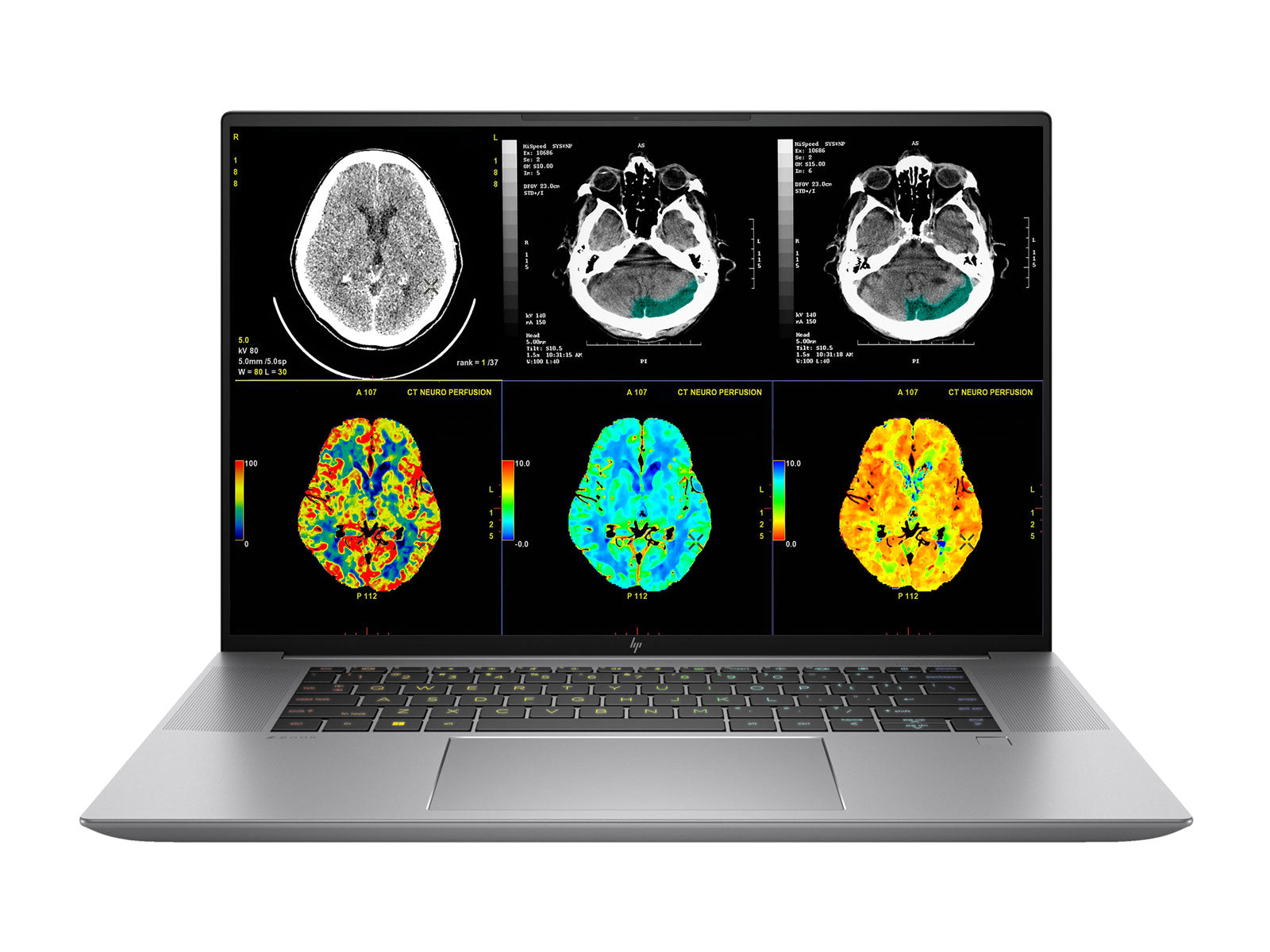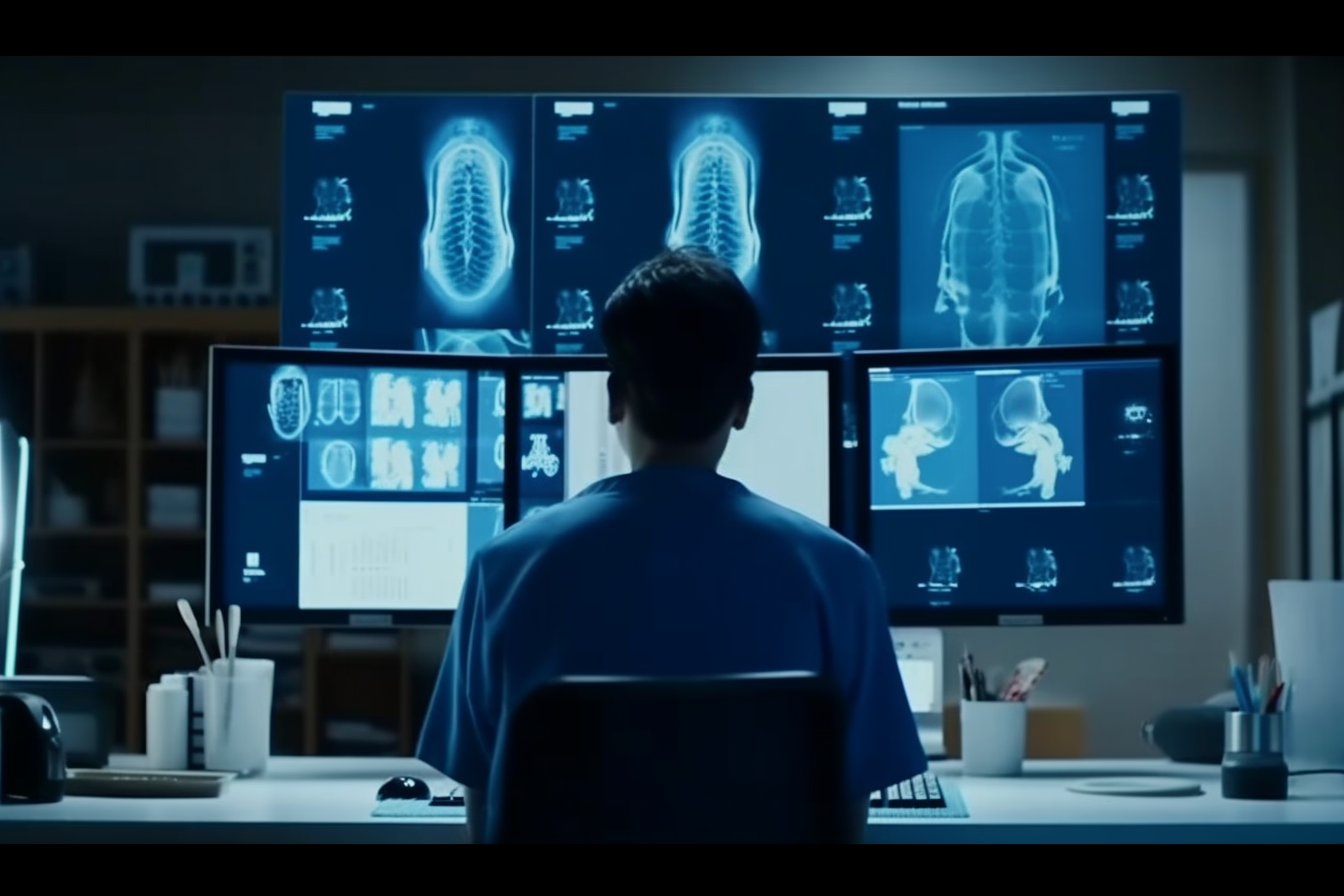HP ZBook Studio 16 G10 Mobile Radiology Workstation | 16" WQUXGA 8MP+ DICOM Calibrated | Core i7-13800H @ 5.2GHz | 64GB DDR5 | 512GB NVMe SSD | Intel Iris Xe 4GB | Win11 Pro
This is The HP ZBook Studio 16 G10 Mobile Workstation—an exemplary mobile PACS workstation crafted for the precision and efficiency demands of the medical field, particularly suited for radiologists. This workstation combines robust processing power, advanced graphics, and high-speed storage in a sleek, durable package designed to handle the rigors of healthcare environments.
Unparalleled Performance
The HP ZBook Studio 16 G10 is powered by the latest 13th Gen Intel Core processors, including options up to the i9-13900H, delivering exceptional performance for intensive tasks such as rendering high-resolution medical images and processing large datasets. The combination of powerful CPUs and up to 64GB of high-speed DDR5 RAM ensures seamless multitasking and efficient workflow management.

Optimized Viewing for Diagnostic Imaging
The 16:10 aspect ratio of the HP ZBook Studio 16 G10 Mobile Radiology Workstation provides 11% more vertical content than a standard 16:9 display, essential for radiologists who need to view more of the image with less scrolling. This improvement helps maintain diagnostic integrity by ensuring vital details are always visible, reducing the need to minimize program menus or toolbars.
The pixel density on the 16-inch WQUXGA display also surpasses that of a typical 17-inch screen, delivering sharper, more detailed images crucial for accurate diagnosis and analysis.
Key Benefits:
- Enhanced Vertical Space: Shows more vertical content, ideal for detailed diagnostic images.
- Improved Workflow: Reduces scrolling, allowing radiologists to focus on image analysis.
- Comprehensive Image Display: Ensures critical details are visible simultaneously.
- Higher Pixel Density: Offers superior image clarity compared to a 17-inch display, enhancing diagnostic accuracy.
PerfectLUM
PerfectLum is specifically designed to optimize the HP ZBook Studio 16 G10’s 4K display, ensuring compliance with medical imaging standards such as DICOM for grayscale accuracy. Its calibration capabilities extend to maintaining the 100% DCI-P3 color gamut offered by the HP ZBook Studio 16 G9, essential for precise radiological diagnostics.


Processor
The HP ZBook Studio 16 G10 is equipped with Intel Core processors designed to meet the demanding requirements of medical imaging and diagnostic tasks.
Processor Highlights:
- Intel Core Family: Featuring processors from the Intel Core family, the ZBook Studio 16 G10 provides robust performance and energy efficiency.
- Multiple Cores and Threads: These processors come with multiple cores and threads, essential for handling complex multitasking applications common in medical imaging.
- Turbo Boost Technology: Intel Turbo Boost Technology allows the processor to increase its frequency dynamically, offering additional performance during demanding tasks.
- Large Cache Sizes: The processors include large cache sizes to enhance processing speed by storing frequently accessed data closer to the processor, reducing latency and improving system responsiveness.
Nvidia RTX Graphics Card
The HP ZBook Studio 16 G10 comes equipped with a versatile range of graphics options, tailored to meet the diagnostic needs of radiologists who require precision and detail in medical imaging. The workstation offers integrated Intel® Iris® Xᵉ Graphics for standard visual tasks and a series of high-performance NVIDIA GPUs to handle more demanding imaging applications:
- NVIDIA RTX™ A1000 (6GB GDDR6): Suitable for moderate imaging tasks, balancing performance and efficiency for everyday diagnostic needs.
- NVIDIA RTX™ 2000 Ada Generation Laptop GPU (8GB GDDR6): Provides robust performance for moderate imaging tasks, making it a versatile choice for a variety of imaging applications.
- NVIDIA RTX™ 3000 Ada Generation Laptop GPU (8GB GDDR6): Suitable for detailed scans and 3D modeling, offering enhanced capabilities for demanding imaging tasks.
- NVIDIA RTX™ 4000 Ada Generation Laptop GPU (12GB GDDR6): Ideal for advanced diagnostic imaging and virtual simulations, providing superior performance for high-resolution, multi-frame radiographs and complex reconstructions.
- NVIDIA GeForce RTX™ 4070 Laptop GPU: Excels in rendering detailed medical visuals and is especially adept at handling dynamic or time-based imaging like fluoroscopy, providing a smooth and detailed viewing experience.
- NVIDIA GeForce RTX™ 4080 Laptop GPU: Best for radiologists seeking ultra-high resolution and rapid processing speeds for dynamic imaging, including real-time image processing and advanced 3D reconstruction tasks.
These GPUs support advanced visual tasks required in radiology, including high-definition decoding and DirectX 12, and are capable of managing multiple high-resolution displays when connected via HP Thunderbolt Dock G2. This is essential for radiologists who require precision in viewing diagnostic images across several monitors. The ECC feature in the higher-end RTX models further ensures data integrity, which is crucial for maintaining accuracy in diagnoses. With this comprehensive GPU setup, the HP ZBook Studio 16 G10 is equipped to meet the demanding and precision-critical needs of modern radiological practices.


SSD
The HP ZBook Studio 16 G10 offers advanced storage solutions to meet the needs of medical imaging professionals who require high-speed data access and large storage capacities.
Storage Highlights:
- Capacity: Up to 4TB PCIe NVMe SSD
- Speed: PCIe NVMe technology ensures rapid read and write speeds, significantly faster than traditional SATA SSDs.
- Reliability: NVMe SSDs are designed for durability and reliability, ensuring that large medical datasets and imaging files are securely stored and quickly accessible.
- Efficiency: The high-speed storage solution enhances overall system responsiveness and reduces load times, essential for efficient workflow management in medical environments.
This extensive storage capacity allows healthcare professionals to handle large imaging files and extensive medical records seamlessly, ensuring that all necessary data is readily available for diagnostic processes.
High-Velocity DDR5 Memory
The HP ZBook Studio 16 G10 is equipped with flexible memory configurations to support demanding multitasking and data-intensive applications common in medical diagnostics.
Memory Highlights:
- Maximum Capacity: Up to 64GB DDR5-5600 RAM
- Slots: Configurable with multiple memory slots to achieve the desired capacity.
- Speed: DDR5 ensures high-speed data processing and efficient multitasking capabilities.
- Reliability: High-speed memory is crucial for running multiple applications simultaneously and managing large datasets without performance degradation.


Experience Enhanced Cooling & Portability
Equipped with HP Vaporforce Thermals, including a new curved metal blade design, the ZBook Studio 16 G10 ensures efficient cooling, maintaining optimal performance during intensive workloads. Despite its powerful components, the workstation is designed to be portable, with a starting weight of just 3.81 lbs (1.73 kg) and a sleek profile.
Advanced Camera Security
The HP ZBook Studio 16 G10 is equipped with a high-quality 5MP IR camera that includes advanced auto-framing features, designed to enhance the user experience during virtual meetings and telehealth consultations.
Camera Highlights:
- 5MP Resolution: Provides high-definition video quality, ensuring clear and detailed images for virtual consultations and collaborative meetings.
- Auto-Framing: The auto-framing feature uses intelligent software to keep the user centered in the frame. This is particularly useful during dynamic video calls where the user might move around, as the camera automatically adjusts to keep the user in focus.
- IR Sensor: Supports Windows Hello facial recognition, allowing for secure and quick login without the need for passwords.
- Privacy Shutter: Includes a physical shutter to cover the camera when not in use, ensuring privacy and security against unauthorized access.


AI Noise Suppression
The HP ZBook Studio 16 G10 is equipped with AI Noise Suppression technology, a feature designed to enhance audio clarity during virtual meetings and collaborative work sessions. This technology intelligently filters out background noise, ensuring that only clear and focused audio is transmitted, making it ideal for medical professionals who often participate in telehealth consultations, remote diagnostics, and collaborative discussions.
AI Noise Suppression Highlights:
- Clear Communication: Enhances voice clarity by reducing background noise, ensuring clear and professional communication in virtual meetings.
- Productivity Boost: Helps maintain focus and productivity by minimizing audio distractions in busy or noisy environments.
- Integration: Seamlessly integrates with commonly used communication platforms, ensuring consistent audio quality across various applications.
This feature is particularly beneficial for medical imaging professionals who need to communicate complex information accurately and clearly without the interference of background noise, thus improving the overall quality of virtual consultations and remote diagnostics.
Ports
With Thunderbolt™ 4 and USB4™ Type-C® connectivity, the HP ZBook Studio 16 G10 offers versatile linking options to various medical imaging equipment, enhancing its utility in diverse medical settings.
01. Power Charging indicator
02. Power Connector
03. Thunderbolt™ 4 with USB4™ Type-C® 40Gbps signaling
04. Headphone/Microphone Combo
05. Woofer
06. Woofer
07. microSD 7.1 media card reader
08. SuperSpeed USB Type-C® 10Gbps signaling rate (Power
Delivery Out, Display Out)
09. Super Speed USB Type-A 5Gbps signaling rate (charging)
10. Nano Security Lock Slot


Dimensions & Weight
The HP ZBook Studio 16 G10 combines a sleek design with robust build quality, making it an ideal choice for medical professionals who need both performance and portability.
Dimensions and Weight Highlights:
- Dimensions (W x D x H): 35.6 x 24.2 x 1.9 cm (14.02 x 9.54 x 0.76 inches)
- Weight: Starting at 1.73 kg (3.81 lbs)
Exceptional Service & Support from Monitors.com
When you purchase from Monitors.com, you not only receive a top-tier workstation but also benefit from our dedication to value and service. We understand the unique needs of healthcare professionals, and that's why we offer:
Advanced Hot Swap: Our Hot Swap capabilities ensure you can seamlessly switch out components without workflow disruption, guaranteeing uninterrupted productivity.
Next Business Day Standard Replacement: Count on our swift replacement service to keep your workstation running smoothly, minimizing downtime.
Free Shipping & Fast Delivery: We respect your time, offering free shipping and lightning-fast delivery to get you started with your workstation without delay.
Dedicated Support Team: Our team of experts is readily available to address any inquiries or issues, making your journey from purchase to setup as seamless as possible.
Competitive Pricing: At Monitors.com, we're committed to delivering exceptional value. You'll find our products competitively priced to fit comfortably within your budget.
Customer Satisfaction: Your contentment is our top priority, and we're dedicated to ensuring you're thrilled with your purchase. We're here to assist you at every step.
Invest in a Monitors.com workstation for not just top-tier hardware but a partnership committed to your success.












